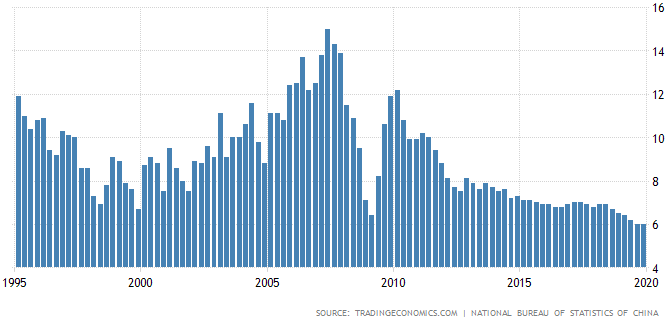A Test For China’s Propaganda Machine
The main purpose of the GDP growth numbers and most other economic statistics reported by China’s government is to tell the story that the central committee of the Communist Party wants to tell. In other words, the economic numbers form part of the State’s propaganda.
For example, during the first decade of this century the Party’s objective was to show that the economy was performing in spectacular fashion, so the reported GDP growth numbers were almost never below 8% and regularly above 10%. In more recent years the overriding concern has been to paint a picture of stability and sustainable progress, which has involved reporting consistent GDP growth in the 6%-7% range. Refer to the following chart for more detail. Amazingly, most Western analysts accept these figures as if they were accurate reflections of reality, partly, we suspect because there is no way to prove that what’s being reported is bogus.
Once in a while, however, something happens that shines a light on the meaninglessness of the official numbers. An example was the claim by China’s government that its economy was still growing at an annualized pace of more than 6% during the worst point of the 2007-2009 global recession. Another example very likely will be the quarterly GDP growth that China’s government reports for the first quarter of this year.

The consensus view in the financial news media appears to be that due to the SARS-CoV-2 virus, China’s GDP growth rate in Q1-2020 will slide from 6%+ to ‘only’ 4%-5%. The reality, however, is that China’s economy could not be growing at the moment. Large sections of the country have been essentially put in lock-down mode, and many factories, restaurants, shops and other businesses have been temporarily closed. Tourism has ground to a halt, home sales have collapsed by 90% and vehicle sales are expected to fall by 50%-80% from the same period last year. In some large Chinese cities, including Shanghai, the government has directed state property owners not to collect rent from small- and medium-sized businesses during February and March.
Other examples of the virus’s dampening effect on economic activity are included in articles published on 13th February at the South China Morning (SCMP) and Caixin. According to the SCMP article:
“Recruitment site Zhaopin said this week that around 10 per cent of firms they surveyed were “on the verge of death”, with around 30 per cent planning job cuts and another 30 per cent saying they could not pay their employees on time.”
Along similar lines, the Caixin article notes:
“Even before the outbreak, many small businesses were already grappling with shrinking sales as China’s economy logged some of its slowest growth in decades. With business now at a standstill during the outbreak, many are facing existential liquidity crises. Large numbers say they are having difficulties just paying salaries, adding they can only survive for a matter of months using their current resources, even if Beijing provides support.”
It should be obvious to anyone with at least rudimentary knowledge of the world that China’s economy is contracting right now. Therefore, if the government reports GDP growth of 4%+ for the first quarter of this year it will be a tacit admission that the official numbers are totally fictitious. By the same token, to retain any semblance of credibility China’s government will have to admit that its economy shrank during the first quarter of this year.
That’s why China’s next quarterly GDP number will be a test.
Disclosure: Zacks.com contains statements and statistics that have been obtained from sources believed to be reliable but are not guaranteed as to accuracy or completeness. References to any specific ...
more


